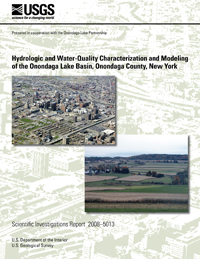Scientific Investigations Report 2008–5013

Prepared in cooperation with the
Onondaga Lake Partnership
Onondaga Lake in Onondaga County, New York, has been identified as one of the Nation’s most contaminated lakes as a result of industrial and sanitary-sewer discharges and stormwater nonpoint sources, and has received priority cleanup status under the national Water Resources Development Act of 1990. A basin-scale precipitation-runoff model of the Onondaga Lake basin was identified as a desirable water-resources management tool to better understand the processes responsible for the generation of loads of sediment and nutrients that are transported to Onondaga Lake. During 2003–07, the U.S. Geological Survey (USGS) developed a model based on the computer program, Hydrological Simulation Program–FORTRAN (HSPF), which simulated overland flow to, and streamflow in, the major tributaries of Onondaga Lake, and loads of sediment, phosphorus, and nitrogen transported to the lake. The simulation period extends from October 1997 through September 2003.
The Onondaga Lake basin was divided into 107 subbasins and within these subbasins, the land area was apportioned among 19 pervious and impervious land types on the basis of land use and land cover, hydrologic soil group (HSG), and aspect. Precipitation data were available from three sources as input to the model. The model simulated streamflow, water temperature, concentrations of dissolved oxygen, and concentrations and loads of sediment, orthophosphate, total phosphorus, nitrate, ammonia, and organic nitrogen in the four major tributaries to Onondaga Lake–Onondaga Creek, Harbor Brook, Ley Creek, and Ninemile Creek. Simulated flows were calibrated to data from nine USGS streamflow-monitoring sites; simulated nutrient concentrations and loads were calibrated to data collected at six of the nine streamflow-monitoring sites. Water-quality samples were collected, processed, and analyzed by personnel from the Onondaga County Department of Water Environment Protection. Several time series of flow, and sediment and nutrient loads were generated for known sources of these constituents, including the Tully Valley mudboils (flow and sediment), Otisco Lake (flow and nutrients), the Marcellus wastewater-treatment plant (flow and nutrients), and springs from carbonate bedrock (flow). Runoff from the impervious sewered areas of the City of Syracuse was adjusted for the quantity that was treatable at the county wastewater-treatment plant; the excess flows were routed to nearby streams through combined-sanitary-and-storm-sewer overflows. The mitigative effects that the Onondaga Reservoir and Otisco Lake were presumed to have on loads of sediment and particulate constituents were simulated by adjustment of parameter values that controlled sediment settling rates, deposition, and scour in the reservoir and lake.
Graphical representations of observed and simulated data, and relevant statistics, were compared to assess model performance. Simulated daily and monthly streamflows were rated “very good” (within 10 percent of observed flows) at all calibration sites, except Onondaga Creek at Cardiff, which was rated “fair” (10–15 percent difference). Simulations of monthly average water temperatures were rated “very good” (within 7 percent of observed temperatures) at all sites. No observed data were available by which to directly assess the model’s simulation of suspended sediment loads. Available measured total suspended solids data provided an indirect means of comparison but, not surprisingly, yielded only “fair” to “poor” ratings (greater than 30 percent difference) for simulated monthly sediment loads at half the water-quality calibration sites. Simulations of monthly orthophosphate loads ranged from “very good” (within 15 percent of measured loads) at three sites to “poor” (greater than 35 percent difference) at one site; simulations of ammonia nitrogen loads ranged from “very good” at one site to “fair” (25–35 percent difference) at two sites. Simulations of monthly total phosphorus, nitrate, and organic nitrogen loads were generally rated “very good” at all calibration sites.
Sources of uncertainty in model results were identified, including (1) errors in precipitation data, (2) limitations in model structure, (3) nonuniqueness of values for highly sensitive parameters, (4) errors or bias in data used to calibrate the different components of the model, (5) misclassification of land-use and land-cover data, (6) changes in land use during the simulation period, (7) unidentified sources or sinks of chemical loads and water-quality processes that varied over time, and (8) differences in scale between large calibrated subbasins and small subbasins to which calibrated parameter values were transferred. Uncertainty in simulations of water-quality constituents was compounded by uncertainty in the processes on which the water-quality simulations were based. Therefore, sediment simulations were affected by uncertainty in the simulation of hydrology, and nutrient simulations were affected by uncertainty in both the hydrologic and sediment processes, as well as, in simulations of water temperature and dissolved oxygen concentrations.
The calibrated model can be used to simulate scenarios that represent planned or hypothetical development and implementation of best-management practices in the Onondaga Lake basin and to assess the effects that these changes and practices are likely to have on rural and urban nonpoint sources of pollution to Onondaga Lake. Model results also can be used as input to a hydrodynamic model of Onondaga Lake that is being developed by Onondaga County and to prioritize areas of the basin where mitigative measures to decrease sediment and nutrient loads could provide the greatest benefits to Onondaga Lake.
Coon, W.F., and Reddy, J.E., 2008, Hydrologic and water-quality characterization and modeling of the Onondaga Lake basin, Onondaga County, New York: U.S. Geological Survey Scientific Investigations Report 2008–5013, 85 p.
For further information, contact:
Director
U.S. Geological Survey
New York Water Science Center
425 Jordan Road
Troy, NY 12180
Email: dc_ny@usgs.gov
Phone: (518)285-5600
Visit our web site: http://ny.water.usgs.gov
This report is available PDF Format (7.1 MB)
If you have Adobe® Acrobat® or Adobe ® Acrobat® Reader® installed on your computer, you may view and print the PDF version of this report. Acrobat Reader, is a free download from Adobe Systems, Inc. Users with disabilities can view information concerning accessibility at access.Adobe.com.